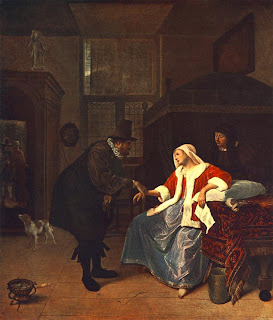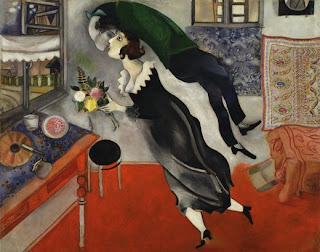Wednesday, December 31st, 2008
J and I obviously didn’t plan on celebrating our anniversary apart from each other. I teased J that he was lucky to get out of planning an anniversary date. Instead, we sent each other e-cards that were decorated with art:

Jan Steen,
Love Sickness, c. 1660
 Marc Chagall, Birthday, 1915
Marc Chagall, Birthday, 1915
Can you guess which person picked which painting?
During the 1660s, Steen painted several scenes of doctors paying house calls to visit female patients. As in this painting, Steen’s doctors usually do not recognize the cause of the female’s ailing health – love sickness. In some of Steen’s paintings that follow this theme, he also includes the phrase, “Here a physician is of no avail, since it is love sickness.” 1 I picked this card for J (yep, it was me!) because I literally got sick to my stomach when J returned home after a study abroad. We were close to getting engaged at that point; my doctor said I experienced too much “positive estress” with J’s return, which led to an excess of acid in my stomach. Now we joke that J gives me ulcers.
In this painting, it appears that this woman is estranged from her lover, as indicated by the letter in her hand. It wasn’t until after I sent J this painting that I realized it is especially appropriate for us today.
Chagall’s painting has a rather melancholy tone, since the woman is dressed in black clothes (perhaps funeral attire). It is thought by some that the woman is celebrating the birthday of a deceased lover; he floats above the woman and contorts his body so that he can give her a kiss. Although I suppose this seems like a morbid painting to send as an anniversary card, it is fitting in the sense that J and I are apart on our special day. Actually, the sentiment that J included with this card (did you guess that he’d pick a 20th century artist?!?) was quite fitting and lovely.
J also pointed out that Chagall’s floating figure is similar (in its awkward positioning and floating-ness) to some paintings by Brian Kershisnik. I don’t know why I didn’t notice that before: Kershisnik’s work is a little Chagallian, don’t you think?
1 Lyckle de Vries. “Steen, Jan.” In Grove Art Online. Oxford Art Online, found online at http://www.oxfordartonline.com.erl.lib.byu.edu/subscriber/article/grove/art/T081140, accessed December 31, 2008.
Thursday, December 18th, 2008
 In the world of art, there are a plethora of depictions of the Nativity story (with many thanks to the Catholic church, perhaps the biggest art patron of all time?). Depictions of the life of Christ begin in the Early Christian period, but during the Romanesque and Medieval periods these depictions of the Nativity (and Christ’s life in general) become even more widespread, not only due to the popularity of Christianity but also because images were used as a teaching tool for illiterate devouts. This capital from the St-Lazare Cathedral (Autun, France) is from the Romanesque period. It’s probably my favorite depiction of the three magi.
In the world of art, there are a plethora of depictions of the Nativity story (with many thanks to the Catholic church, perhaps the biggest art patron of all time?). Depictions of the life of Christ begin in the Early Christian period, but during the Romanesque and Medieval periods these depictions of the Nativity (and Christ’s life in general) become even more widespread, not only due to the popularity of Christianity but also because images were used as a teaching tool for illiterate devouts. This capital from the St-Lazare Cathedral (Autun, France) is from the Romanesque period. It’s probably my favorite depiction of the three magi.
This capital was sculpted by Gislebertus, one of the few known sculptors during the Romanesque period.1 I really, really heart Gislebertus and his work. Not only does he have great textures and details (look at the crowns on the kings and the texture of the blanket), but he’s a great storyteller with a sense of humor. This capital (a capital decorates the top part of a column) contains a depiction of the angel coming to the three magi, telling them to not go through Jerusalem on their way back from visiting the Christ child. The angel is gently touching the hand of one of the kings – and see how the king’s eyes are wide open? I think it’s a great expression of one who has just been woken up, particularly one who has just been woken up by an angel. Classic. Plus, I love the idea of three ancient kings squeezed together under one blanket, sharing one big pillow, and sleeping with their crowns on their heads.
 The other sculptures by Gislebertus at St-Lazare include a door lintel depicting Eve, as well as a tympanum of the Last Judgment. This tympanum is one of my all-time favorite sculptural reliefs on a cathedral. This is a detail from the tympanum, showing St. Michael weighing the souls of an individual with the help of a scale (as part of the judgment process). On the left is St. Michael, and on the right is a demon who is trying to tip the scale to be in his favor. The elongated proportions of the demons in this tympanum make them seem all the more gruesome. There are other gaunt and writhing demons depicted on this tympanum as well, straining to grab at the souls of the damned. And if that doesn’t scare you into being righteous, an inscription below the scales is included for the literate viewer: “May this terror terrify those whom earthly error binds, for the horror of these images here in this manner truly depicts what will be.”
The other sculptures by Gislebertus at St-Lazare include a door lintel depicting Eve, as well as a tympanum of the Last Judgment. This tympanum is one of my all-time favorite sculptural reliefs on a cathedral. This is a detail from the tympanum, showing St. Michael weighing the souls of an individual with the help of a scale (as part of the judgment process). On the left is St. Michael, and on the right is a demon who is trying to tip the scale to be in his favor. The elongated proportions of the demons in this tympanum make them seem all the more gruesome. There are other gaunt and writhing demons depicted on this tympanum as well, straining to grab at the souls of the damned. And if that doesn’t scare you into being righteous, an inscription below the scales is included for the literate viewer: “May this terror terrify those whom earthly error binds, for the horror of these images here in this manner truly depicts what will be.”
Anyone intimidated yet?
All in all, I think Gislebertus is a really creative and innovative sculptor. The clever interaction between figures and details have caused scholars to pinpoint Gislebertus as a very modern sculptor for his time. I love these works from the St-Lazare Cathedral; they help add a touch of personality and humor to the surviving works of the Romanesque period.
1 UPDATE: A theory proposed by Linda Seidel (1998) suggests that Gislebertus may not have been the sculptor at Autun Cathedral, but a Carolingian count who was a financial patron for the church. For more information, see here.
Friday, December 5th, 2008
I’ve been feeling rather out of my element lately (what a surprise, after having moved across the country!), and I realized today that it is partially because I haven’t been able to read any art history articles. So, today I read up on Elizabeth Siddal, the infamous model for several Pre-Raphaelite painters. Elizabeth Siddal has fascinated art historians and writers for a long time, particularly due to her relationship with the painter Dante Gabriel Rossetti. Probably the most famous story regarding Siddal is when she modeled for Millais’ painting of Ophelia; she lay for hours in a bathtub, fully clothed, and later became sick due to the prolonged exposure to cold water.
 Siddal modeled for this painting, A Pet, by Deverell (exhibited 1853). The painting depicts pet birds surrounding Siddal in a garden setting. In an interesting article that uses this painting as a starting ground, Elaine Shefer explores the idea of birds and pets in comparison with the relationship between Siddal and Rossetti.1 Shefer analyzes different Pre-Raphaelite paintings, as well as poetry by Siddal and Rossetti, to show how the model was like a “bird in a cage” in her relationship with the painter. Undoubtedly, Siddal had a very sad life (which ended in a purported suicide). Some really fascinating aspects of Shefer’s argument comes at the end of the article. For example, she includes discussion of how Rossetti was haunted by the voices of birds after Siddal’s death; on at least two occasions the birds “spoke to him accusingly, once with the voice of Lizzie.”2
Siddal modeled for this painting, A Pet, by Deverell (exhibited 1853). The painting depicts pet birds surrounding Siddal in a garden setting. In an interesting article that uses this painting as a starting ground, Elaine Shefer explores the idea of birds and pets in comparison with the relationship between Siddal and Rossetti.1 Shefer analyzes different Pre-Raphaelite paintings, as well as poetry by Siddal and Rossetti, to show how the model was like a “bird in a cage” in her relationship with the painter. Undoubtedly, Siddal had a very sad life (which ended in a purported suicide). Some really fascinating aspects of Shefer’s argument comes at the end of the article. For example, she includes discussion of how Rossetti was haunted by the voices of birds after Siddal’s death; on at least two occasions the birds “spoke to him accusingly, once with the voice of Lizzie.”2
This is a really interesting psychological analysis of the relationship between two well-known figures from 19th century art. I haven’t found a plethora of scholarly analysis on the Pre-Raphaelites (with the exception of a few writings, like those done by Griselda Pollock). However, this article by Shefer is a nice psychological study that is well-supported with social-historical evidence.
1 Elaine Shefer, “Deverell, Rossetti, Siddal, and ‘The Bird in the Cage’,” The Art Bulletin 67, no. 3 (September, 1985): 437-48.
2 Ibid., 446.
Wednesday, December 3rd, 2008
 J just got an email from the Josef Albers Foundation. Apparently, the foundation is busy making a catalogue raisonne of all of the paintings by Albers. It looks like our Homage to the Square project won’t come to fruition, since the foundation is unlikely to sponsor or help with an additional project of a similar nature.
J just got an email from the Josef Albers Foundation. Apparently, the foundation is busy making a catalogue raisonne of all of the paintings by Albers. It looks like our Homage to the Square project won’t come to fruition, since the foundation is unlikely to sponsor or help with an additional project of a similar nature.
Sniff. Sniff.
I told J to look on the bright side – at least he was able to convince me to buy two rare, out-of-print books on Homage to the Square that I wouldn’t have been willing to purchase otherwise. And hey, at least a catalogue is being made…
 Jan Steen, Love Sickness, c. 1660
Jan Steen, Love Sickness, c. 1660




